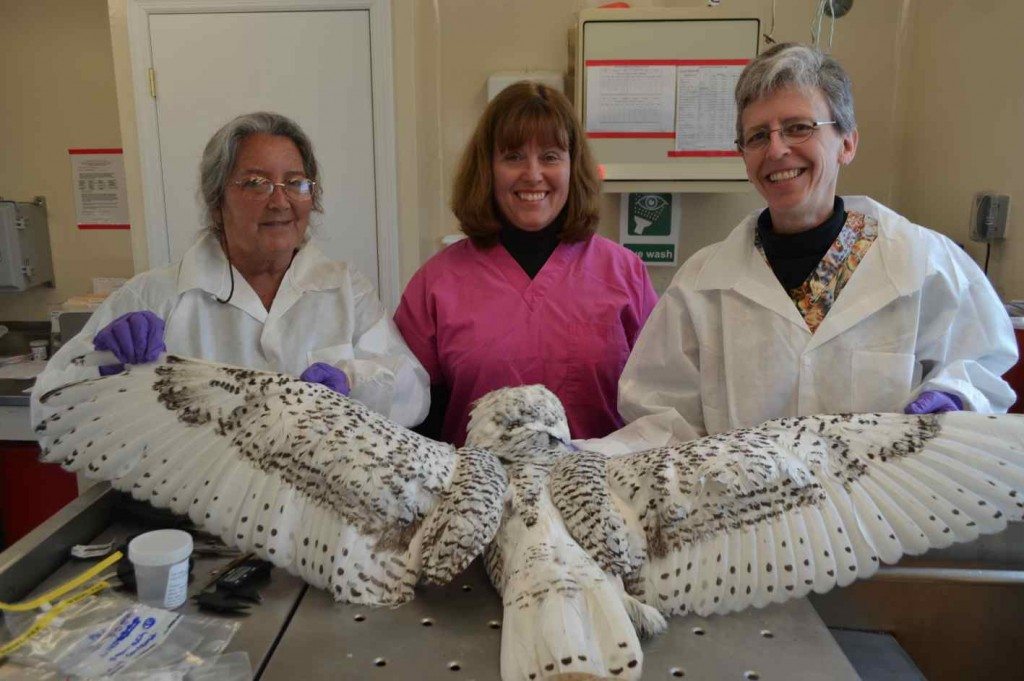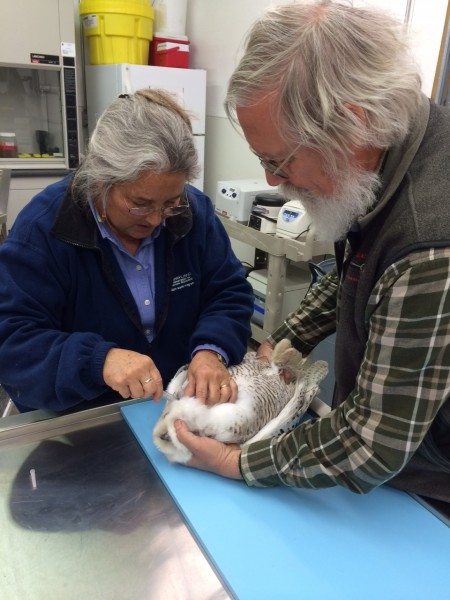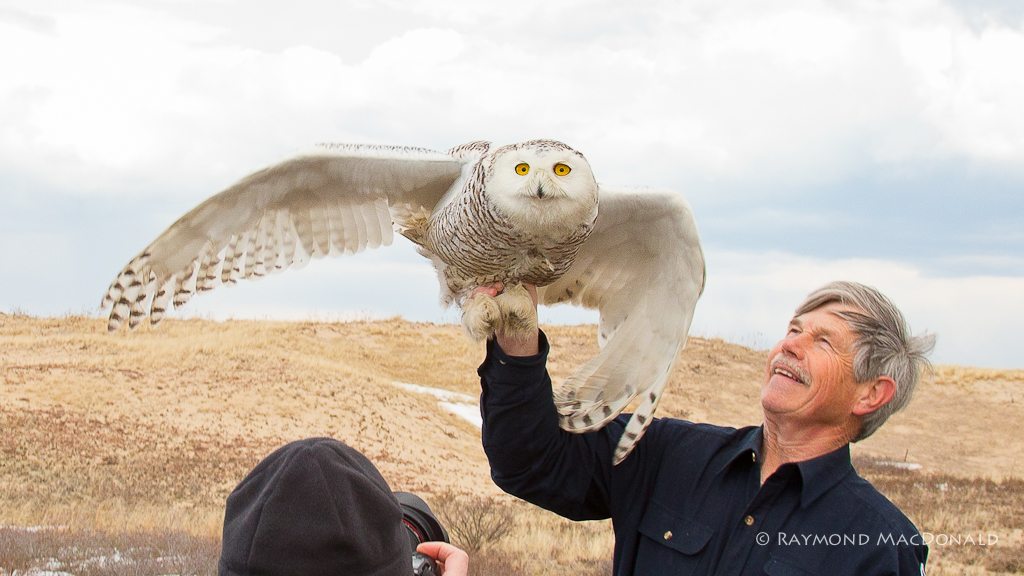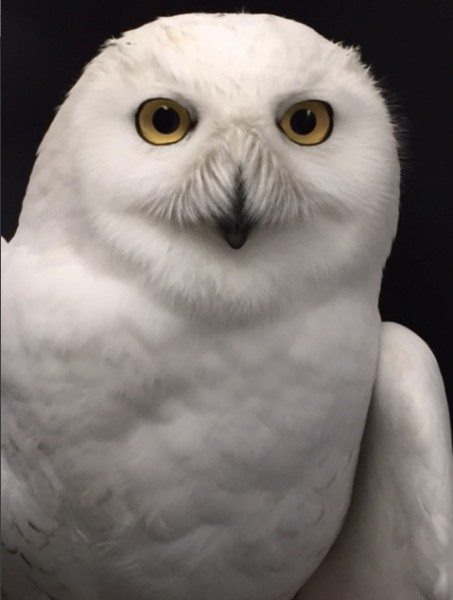
From left, Drs. Cindy Driscoll, Sherrill Davison and Erica Miller prepare to perform a necropsy on a salvaged snowy owl. The SNOWstorm team has conducted such painstaking exams on more than 150 snowy owls found dead, to learn more about the risks they face.
We’re marking the third anniversary of Project SNOWstorm, which kicked off in December 2013 with our first tagged snowy owls. This is the third and final look back at what we’ve been able to do with your help, since SNOWstorm is funded entirely by donations from the public.
In the lab: While the GPS transmitters we’ve placed on more than 40 owls garners the most attention, some of our most important work has taken place in the lab, with our team of wildlife veterinarians and pathologist under the direction of Dr. Cindy Driscoll of Maryland’s Department of Natural Resources.
When we capture an owl for banding or tagging, we frequently take blood and feather samples, which give us insights into the bird’s health, origin and genetics. And while no one likes to see it happen, when a snowy owl is found dead — from accident, disease or other mishap — Cindy’s team takes the opportunity to peer even more deeply into the health and condition of these birds.

Dr. Cindy Driscoll and SNOWstorm co-founder Dave Brinker work with a live snowy owl in Cindy’s lab in Maryland.
Over the past three years, more than 150 salvaged snowy owl carcasses have been necropsied at the University of Pennsylvania’s pathology lab run by Dr. Sherrill Davison, with Cindy and Dr. Erica Miller of the Brandywine (DE) Zoo and University of Pennsylvania assisting. The owls came from nine states, the District of Columbia and Canada; 55 percent were male, 38 percent female, and the remainder were partial carcasses that couldn’t be sexed.
The necropsies confirm what previous research has suggested — that most snowy owls coming south during irruptions are healthy, and in good weight and fat. A little more than a quarter had intestinal parasites (we know relatively little about what constitutes a normal occurrence in this species) while two-thirds had external parasites, largely feather lice.
Examinations showed almost half of the salvaged owls died from trauma, usually vehicle or airplane collisions. Half also showed some level of the long-banned (but highly persistent) pesticide DDT, and many had worrisome levels of mercury in their feathers, blood or tissues. (We are now focusing even more closely on the mercury issue, with assistance from our SNOWstorm colleagues at the Biodiversity Research Institute in Maine, acknowledged experts in mercury contamination. And we’re targeting our tagging efforts in part to see how owl behavior — coastal vs. inland, preying on waterbirds vs. preying on mammals — may impact mercury exposure.)
Samples we take from both living and salvaged snowies hold other secrets that we’re beginning to tease out. Skin cells that adhere to the base of the feather quill contain DNA that can shed light on the genetic structure of snowy owl populations, while blood and feathers can be analyzed for stable chemical isotopes — variants of chemical elements like deuterium and carbon that can tell us a lot about an owl’s place of origin, changes in its diet over time (such as whether it’s been feeding in a terrestrial or marine environment) and a great deal more.

Norman Smith prepares to release Century, the 100th snowy owl (of more than 150 total) he relocated from Logan Airport in Boston in the winter of 2013-14. (©Raymond MacDonald)
Making airports safer: We know that airports are dangerous places for snowy owls, and that owls can pose a significant hazard for aircraft. That’s why Project SNOWstorm has from the start worked with airport authorities and the USDA Wildlife Services to find better ways to minimize deadly conflicts between snowy owls and airplanes, and to develop best practices for relocating snowy owls so they stay away from airfields once they’re trapped and moved.
No one has been more active on this front than SNOWstorm co-founder Norman Smith of Massachusetts Audubon, who since 1981 has been working with Logan Airport in Boston to trap and relocate snowy owls. Norman conducted the first satellite tagging of snowies on the wintering

Your help makes the work we do at Project SNOWstorm possible — thank you. (©Julie Breheny)
grounds, and conducted many of the earliest studies (often using night-vision equipment) to see what the owls were doing after dark. During the major irruption of 2013-14, Norman moved more than 150 snowies from Logan, so that neither the owls nor the planes came to a bad end.
More to come! That’s it for our look back, but there’s a lot more to share in the days ahead. We’re poised to begin tagging up to 10 additional owls this winter — and we have exciting news about a couple of previously tagged owls that are already back within cell range.
So stay tuned for what promises to be another exhilarating winter of snowy owl research. And if you haven’t done so, please consider helping our Indiegogo/Generosity campaign, through which your tax-deductible contribution — Project SNOWstorm’s sole means of support — can help us continue this vital work.

